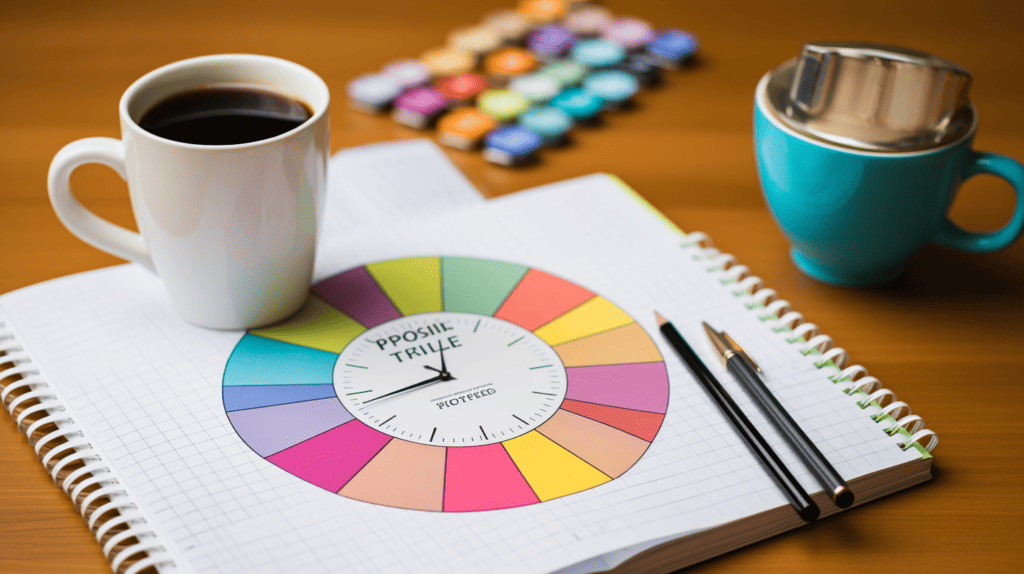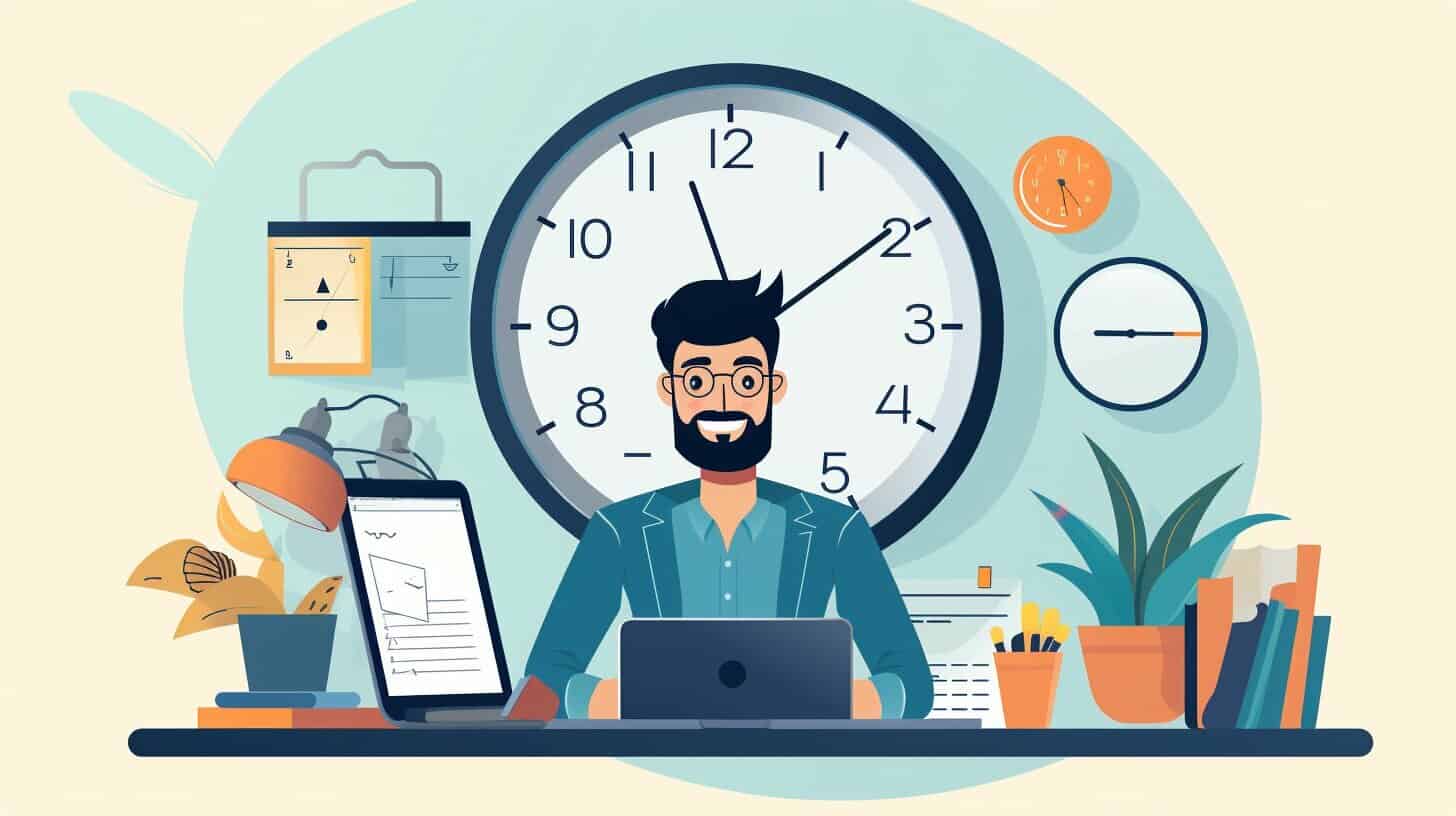Welcome to my article on manage your workday now! As a professional journalist and copywriter, I understand the challenges of managing a busy work schedule. That’s why I’ve compiled expert tips and strategies for efficient success in managing your workday.
Effective workday management is essential for productivity, work-life balance, and overall satisfaction. By implementing the right strategies and tools, you can optimize your workday and achieve success both professionally and personally.
Key Takeaways:
- Workday management is crucial for productivity and work-life balance
- Implementing the right strategies and tools can optimize your workday for efficient success
The Benefits of Workday Management
As someone who has experienced the chaos and stress of an unstructured workday, I can attest to the value of workday management. Implementing productivity hacks, efficient work routines, and workday organization strategies has transformed my workday from overwhelming to manageable and even enjoyable. If you’re like me, you’re probably wondering: what are the benefits of workday management? I’m glad you asked!
The Benefits
| Benefit | Description |
|---|---|
| Increased productivity | By prioritizing tasks, setting a schedule, and minimizing distractions, you can boost your productivity and get more done in less time. |
| Improved work-life balance | Workday management enables you to structure your workday to accommodate your personal life and reduce stress. |
| Reduced stress | Knowing what tasks to focus on and when, and having a structured workday, can significantly reduce the stress and anxiety associated with a chaotic workday. |
| Increased job satisfaction | Having a manageable workload and a sense of control over your workday can lead to Increased job satisfaction and overall happiness. |
“Implementing workday management strategies has transformed my workday from overwhelming to manageable and even enjoyable.”
As you can see, workday management is a game-changer. By implementing productivity hacks, efficient work routines, and workday organization strategies, you can reap the benefits of a more structured and manageable workday. In the following sections, we’ll dive deeper into the specific strategies you can use to manage your workday effectively.
Setting Clear Priorities
Effective workday management starts with setting clear priorities. Without a plan of action, it’s easy to get bogged down in the details and lose sight of the big picture. Here are some essential time management tools and task management strategies to help you prioritize tasks and optimize productivity:
1. Prioritize Tasks
The first step is to make a list of all the tasks that need to be completed. Next, prioritize these tasks based on urgency and importance. Use a task management app or a to-do list to keep track of your tasks and deadlines. This will help you stay organized and focused throughout the day.
2. Use the Two-Minute Rule
If a task takes less than two minutes, do it immediately. This simple rule can help you tackle small tasks and prevent them from piling up on your to-do list.
3. Plan Your Day Ahead
Take a few minutes at the end of each day to plan your schedule for the next day. This will help you prioritize your tasks and start your day with a clear plan of action.
By setting clear priorities, you can manage your workday more effectively and accomplish more in less time. Implement these tips and start optimizing your workday for maximum productivity and success.

Creating a Daily Schedule
One of the most effective ways to manage your workday is by creating and sticking to a daily schedule. A structured schedule can help you achieve more in less time and ensure that you accomplish your most important tasks.
To create a daily schedule, start by listing out the tasks you need to complete each day. Prioritize them based on their importance and urgency. Next, allocate specific blocks of time to each task, focusing on completing the most critical ones first.
When creating your schedule, consider your natural energy levels and peak productivity times. For instance, if you are most productive in the morning, schedule your most challenging tasks during this time.
To effectively manage your workday, utilize time management tools and productivity apps. These digital solutions can assist in creating and sticking to your daily schedule, ensuring you stay on track and maximize productivity.
Effective Time Blocking Techniques
One of the most effective strategies for managing your workday is time blocking, which involves breaking down your day into specific time chunks dedicated to different tasks. Here are some techniques for effective time blocking:
- Identify your priorities: Before you begin time blocking, identify the most important tasks that need to be accomplished that day. Prioritizing ensures that you focus on the most important tasks first and avoid wasting time on less important ones.
- Allocate time for each task: Assign a specific amount of time to each task on your to-do list. This will help ensure that you complete each task within a defined timeframe and avoid getting sidetracked or overwhelmed by a single task.
- Group similar tasks together: Grouping similar tasks together allows you to complete them more efficiently. For example, if you have multiple emails to respond to, try to complete them all during one time block instead of spreading them out throughout the day.
- Take breaks: Taking breaks throughout the day can help you remain focused and energized. Schedule short breaks between time blocks to help you recharge and maintain productivity.
By implementing effective time blocking techniques, you can optimize your workday management and achieve greater productivity and efficiency.

Streamlining Communication and Collaboration
Collaboration is essential in most workplaces, and it can be tricky to manage at times. However, communication plays a vital role in simplifying collaboration.
One of the most effective ways to streamline communication is by using collaboration tools. These tools can allow me to send messages, share files, and collaborate in real-time with colleagues. By using these tools, I can save time and avoid the hassle of searching through my inbox or scrolling through endless chat logs for important information.
In addition to using collaboration tools, I also ensure that each team member has clear expectations and understands their role in a project. By providing clear guidance and establishing expectations and responsibilities, I minimize confusion and promote efficiency within the team.
Finally, I make sure to touch base with my team members regularly. By scheduling regular check-ins, I ensure everyone is on the same page and identify any issues that need addressing before they escalate. This way, I can maintain efficient work routines and ensure that projects stay on track.
Minimizing Distractions and Enhancing Focus
As much as we try to stay focused, distractions can easily derail our workday productivity. That’s why it’s crucial to minimize any potential distractions and enhance our focus. Here are some effective strategies to help:
Create a Conducive Work Environment
Turning your workspace into a distraction-free zone can work wonders for your productivity. Try to eliminate any unnecessary objects or decor that might take your focus away from work. Additionally, make sure you have adequate lighting and comfortable seating, which can help you stay alert throughout the day.
Manage Interruptions
Interruptions can be inevitable at times, but there are ways to manage them. Consider turning off your phone notifications, closing email tabs or using website blockers to limit your access to distracting websites during work hours. Also, let your colleagues or family members know when you need to focus on a task and limit any disruptions.
Stay Focused on Tasks
One effective way to enhance your focus is by using the Pomodoro Technique. This method involves working on a task for 25 minutes, taking a five-minute break, and then repeating the cycle for several hours. By breaking up your workday into smaller, manageable chunks, you can stay focused and avoid burnout.
In conclusion, by minimizing distractions and enhancing focus, you can take control of your workday and boost your productivity. Try incorporating these strategies into your routine and see the difference it can make.

Utilizing Technology for Workday Management
As a professional copywriting journalist, I understand the need for efficient workday management. And in today’s digital age, technology can play a significant role in optimizing productivity. Here are some ways to utilize technology for workday management:
| Productivity Apps | Project Management Tools | Digital Calendars |
|---|---|---|
| Todoist: A task management app that helps prioritize and organize tasks. | Asana: A collaborative project management tool that streamlines communication and task delegation. | Google Calendar: A digital calendar that can sync with other devices and send reminders for appointments and deadlines. |
| Forest: An app that encourages focus and productivity by growing a virtual tree for every block of time spent without distractions. | Trello: A visual project management tool that allows for easy tracking of progress and task assignment. | Outlook Calendar: A popular option for scheduling appointments and meetings, with the ability to view availability and schedule conflicts. |
| RescueTime: A time-tracking app that provides data on how time is spent throughout the workday. | Basecamp: A project management tool that combines task lists, schedules, and team communication. | iCal: A built-in digital calendar for Apple devices that can sync with other calendars and send reminders. |
By utilizing these productivity apps, project management tools, and digital calendars, workday organization can be streamlined and optimized for maximum productivity.
“Technology can play a significant role in optimizing productivity.”
However, it’s important to remember that technology should enhance, not replace, effective workday management. It’s still essential to have efficient work routines, clear task prioritization, and good communication and collaboration processes in place. But by incorporating technology into your workday management strategy, you can take your productivity to the next level.
Balancing Work and Personal Life
As a professional copywriting journalist, it’s essential to maintain a healthy balance between work and personal life. Managing your workday efficiently is key to achieving this balance. However, it’s equally important to make time for personal life and self-care activities.
One effective strategy for balancing work and personal life is to establish boundaries. When working from home, it’s tempting to continue working outside of regular working hours. However, I make it a point to establish a clear division between my work and personal time.
Another useful technique is to schedule personal and self-care activities into my workday routine. Whether it’s going for a run, meeting a friend for lunch, or indulging in a favorite hobby, I make sure to set aside dedicated time for these activities.
I also prioritize self-care activities to ensure I am in optimal mental and physical shape. This includes making time for exercise, meditation, or other relaxation techniques.
By balancing work and personal life, I can maintain a healthy and fulfilling lifestyle while also achieving efficient success in managing my workday.

Evaluating and Adjusting Your Workday Routine
Regularly evaluating and adjusting your workday routine is crucial to maintaining optimum productivity and workday management. By doing so, you can identify inefficiencies, make necessary adjustments, and continuously improve your workflow.
One way to evaluate your workday routine is to monitor your time spent on different tasks. This can help you identify which tasks are taking up too much time and where adjustments can be made. Keeping a task journal or using time tracking apps can be helpful in this regard.
It’s also important to assess your work environment and workspace. Is your workspace comfortable and conducive to productivity? Are there distractions that can be minimized or eliminated? By making small adjustments to your workspace, you can optimize your work environment and ensure maximum focus and productivity.
Making Adjustments
Once you have assessed your workday routine and identified areas that need improvement, it’s time to make adjustments. This may involve reorganizing your schedule, delegating tasks, or finding new tools and resources to assist in your workday management.
Remember, it’s important to be flexible and adaptable in your workday routine. Experiment with different strategies and techniques to find what works best for you. Don’t be afraid to seek advice from colleagues or experts in your field.
Continuously Improving
Finally, remember that workday management is an ongoing process. As your workload and responsibilities change, so too should your workday routine. It’s important to continuously assess and adjust your routine to ensure continued productivity and success.
By regularly evaluating and adjusting your workday routine, you can optimize your workflow and achieve efficient success in managing your workday.
Implementing Workday Management Strategies
Now that we have explored the various workday management strategies, it’s time to take action and implement them into our daily routines. By doing so, we can optimize productivity, enhance workday organization, and achieve efficient success in managing our workday. Here are some tips to help you get started:
- Choose the strategies that work best for you: Not every strategy will work for every individual. Experiment and identify the methods that best fit your work style and personal preferences.
- Start small: Incorporate one or two strategies at a time to avoid overwhelming yourself. Once these become habitual, add additional strategies as needed.
- Stay consistent: Consistency is key in making habits stick. Commit to implementing your chosen strategies consistently to see results.
- Be open to adjustments: As you implement your chosen strategies, be open to adjusting them as needed to fit your evolving workday needs.
Remember, managing your workday is an ongoing process. Continuously evaluate and adjust your strategies to ensure they are optimizing your productivity and work-life balance. With commitment and consistency, you can achieve efficient success in managing your workday.
Conclusion on Manage Your Workday Now
Managing your workday efficiently is key to achieving success in both your professional and personal life. By implementing the workday management strategies discussed in this article, you can optimize your productivity, achieve a healthy work-life balance, and ultimately, reach your goals.
Remember to set clear priorities, create a daily schedule, utilize time blocking techniques, streamline communication and collaboration, minimize distractions, and use technology to your advantage. Additionally, it’s important to maintain a healthy work-life balance and regularly evaluate and adjust your workday routine to ensure continued success.
So, let’s take action and manage our workdays now! With dedication and commitment, we can achieve efficient success in our work and personal lives, and ultimately, enhance our overall well-being.
FAQ on Manage Your Workday Now
Q: What is workday management?
A: Workday management refers to the process of effectively organizing and prioritizing tasks and activities to optimize productivity and efficiency throughout the workday.
Q: Why is workday management important?
A: Workday management is important because it allows individuals to maximize their productivity, improve work-life balance, and ensure that tasks and responsibilities are completed in a timely manner.
Q: What are some productivity hacks for workday management?
A: Some productivity hacks for workday management include using time management tools, setting clear priorities, utilizing task management strategies, and minimizing distractions.
Q: How can I set clear priorities for my workday?
A: You can set clear priorities for your workday by evaluating tasks based on importance and urgency, utilizing time management tools, and creating a to-do list or schedule.
Q: What are some time management tools that can help with workday management?
A: Some time management tools that can help with workday management include to-do list apps, calendar apps, project management software, and time tracking tools.
Q: How can I create a daily schedule for my workday?
A: You can create a daily schedule for your workday by allocating specific time blocks for different tasks and activities, utilizing a calendar or planner, and considering your peak productivity times.
Q: What are effective time blocking techniques?
A: Effective time blocking techniques involve allocating specific time blocks for different tasks or activities, focusing on one task at a time, and avoiding multitasking.
Q: How can I streamline communication and collaboration for workday management?
A: You can streamline communication and collaboration for workday management by utilizing project management tools, setting clear expectations and deadlines, and establishing effective communication channels.
Q: What strategies can I use to minimize distractions and enhance focus during my workday?
A: Some strategies to minimize distractions and enhance focus during your workday include creating a dedicated work environment, managing interruptions, utilizing time management techniques, and practicing mindfulness.
Q: How can technology assist with workday management?
A: Technology can assist with workday management by providing productivity apps, project management tools, time tracking software, and digital solutions to help with task organization, communication, and collaboration.
Q: How can I achieve work-life balance while managing my workday?
A: You can achieve work-life balance while managing your workday by setting boundaries, prioritizing self-care, scheduling time for personal activities, and maintaining open communication with colleagues and loved ones.
Q: Why is it important to regularly evaluate and adjust your workday routine?
A: Regularly evaluating and adjusting your workday routine is important because it allows you to identify inefficiencies, make necessary improvements, and ensure that your workday management strategies continue to be effective.
Q: How can I implement workday management strategies?
A: You can implement workday management strategies by setting clear goals, prioritizing tasks, utilizing time management tools, establishing routines, and consistently evaluating and adjusting your approach.





Leave a Reply